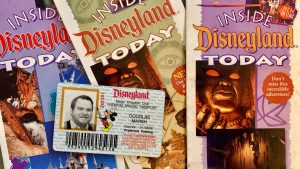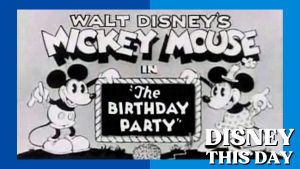For Pulitzer Prize-winning author James B. Stewart, the day has taken on the frenetic pace of Mr. Toad’s Wild Ride at Disneyland: A TV gig just after the break of dawn in Oakland. A public-radio interview in San Francisco. A call to the London Times from the car. Appearances on CBS, CNN and CNBC. A sit-down chat with a local newspaper. And, finally, an evening speech to the Commonwealth Club.
“It’s been go, go, go since I got here,” he tells a reporter as he finally pauses to catch his breath in the lobby lounge of San Francisco’s Argent Hotel.
Not that he’s complaining. On the contrary, Stewart is savoring one of those exhilarating moments when an author’s latest work conveniently dovetails with the headlines of the moment. Just a few weeks ago, “DisneyWar,” his compelling, no-holds-barred account of CEO Michael Eisner’s tumultuous 20-year reign at the Magic Kingdom, leaped onto the best-sellers list. And only a few hours before Stewart arrived in the Bay Area to begin the West Coast leg of his promotional book tour came the stunning news that Eisner would be handing over his throne to company president Robert Iger in October.
Hence, the mad rush by media outlets to get Stewart’s insightful views on the matter.
“Eisner simply stayed on too long. He had to be pushed out rather than have the graceful exit,” Stewart says. “But, in some ways, it’s understandable. Being Disney CEO is kind of like royalty — maybe better than royalty. Money is no object. The corporate jet is ready to whisk you anywhere at any time. The armada of SUVs is there to drive you around. The handlers, the PR people, the wardrobe consultants. … Anything you want is at your fingertips, and it’s got to be very tough to give that up.”
Stewart, a New York-based former reporter and editor for the Wall Street Journal, spent nearly three years meticulously examining the Disney culture. Along the way he learned that Eisner’s many minions didn’t exactly whistle while they worked. The head man apparently fostered a cutthroat management style designed to undermine the authority of his subordinates while bolstering his own. He routinely dangled promotions, then withheld them. He would bad-mouth fellow employees behind their backs and play one off against the other.
“I’m not so naive to have thought it was the happiest place on Earth as it likes to promote itself, but I was shocked by the kind of treacherous, Machiavellian, vicious atmosphere that prevailed at the top,” Stewart says. “One executive said it was like putting six pit bulls in the ring and having Eisner wait to see which one lived.”
Over its 400-plus pages, “DisneyWar” chronicles in vivid detail the Eisner reign, which, early on, propelled the company to dizzying heights of profitability. As the Disney empire expanded into a massive media conglomerate — adding a network (ABC), cable channels and Broadway shows, among other things — Eisner became one of the most famous and most richly remunerated bosses in American business.
But, according to Stewart, Eisner’s ego rapidly expanded as well, which led to severed relationships with embittered Disney executives. He waged well-publicized lawsuit clashes with Jeffrey Katztenberg (the former head of Disney’s movie studios, who pocketed a settlement of $280 million) and Michael Ovitz (his former best friend, who received a $140 million payout); and, in recent years, he feuded openly with Roy E. Disney, Walt’s nephew.
Eisner’s fallout with Roy is one of the many juicy ironies embedded in the Disney saga. It was Roy who helped lure away Eisner from Paramount Pictures in 1984, and it was Roy who, along with longtime Disney board member Stanley Gold, led a stockholder revolt against Eisner last year
Eisner’s dysfunctional management style might have been tolerated longer by a compliant board if his bad business decisions and creative missteps hadn’t rapidly piled up. In addition to the reckless overspending on Euro Disney, a botched foray into the Internet and a mishandled acquisition of the Fox Family Channel (moves that squandered billions), Stewart details how Eisner let slip through his hands such lucrative properties as “The Lord of the Rings” and “Fahrenheit 911” in feature films and “CSI” and “Survivor” in television. Add to that the fractured relationships with highly respected film partners Pixar and Miramax — and the sad decline of a once-fabled animation unit — and you have a fall from grace with Shakespearean overtones.
“The corporation today is the medieval kingdom of our era,” Stewart says. “And this was someone who came to power, then dispatched his rivals and attained absolute power. Then you see that absolute power stifling the creative spirit of the company and corrupting Eisner as his ego just gets bigger and bigger. That, to me, is a universal lesson that goes beyond anything unique to Disney.”
When Stewart launched into his Disney project, he had no idea it would become the story of Eisner’s downfall. He mainly wanted to give readers a behind-the-scenes glimpse into Hollywood’s creative process by showing how the company made its movies, TV shows and theme-park rides.
“I’d done a book on Wall Street (‘Den of Thieves’) and Washington (‘Blood Sport’) and I was kind of thinking: what’s the next sort of obvious center of money, power, and influence in America?” Stewart says. “I’ve always thought Hollywood is part of that triangle and Disney, obviously, its best-known name. And like most Americans, I felt a personal connection. My family went to Disneyland when we were kids, and I loved it. And those animated classics were the first films I ever saw.”
But what started out as a rather pleasurable trip into the so-called Disney magic (Stewart writes of donning a Goofy costume at Disney World for a George Plimpton-like experience) took on an entirely different dynamic when Roy Disney quit the board in 2003 and declared war on Eisner. Relying on interviews with past and present Disney employees, as well as reams of court documents, company correspondence and more, Stewart began piecing together a tale of an imperial CEO who controlled his board of directors like a puppet master and, essentially, ran amok.
“The limits to where he would go were breathtaking,” says Stewart. “You couldn’t make this up and have people believe it.”
As for Iger, the incoming Disney CEO, Stewart has some friendly advice.
“The company is just too big for one person at the top to be making all the critical creative decisions,” he says. “He needs to be less of a star (than Eisner) and be willing to let the other various creative geniuses have their visions.”





